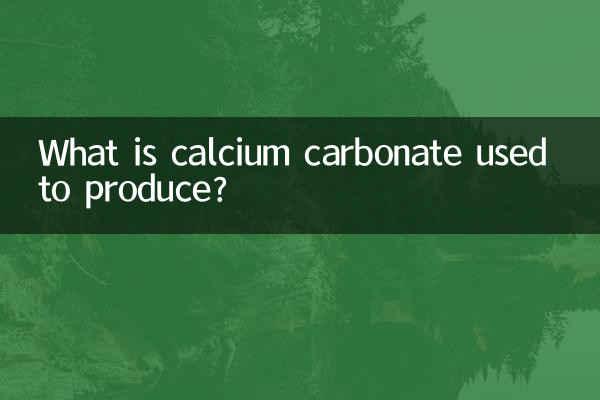What is calcium carbonate used to produce?
Calcium carbonate is an important chemical substance widely used in industry, medicine, food and other fields. Its production methods are diverse, the sources of raw materials are rich, and different production processes are suitable for different application scenarios. This article will systematically introduce the production methods, raw material sources and application fields of calcium carbonate based on the hot topics and hot content on the Internet in the past 10 days.
1. Production method of calcium carbonate

The production of calcium carbonate is mainly divided into two methods: natural mining and chemical synthesis. Here is a comparison of the two methods:
| production method | raw materials | Process characteristics | Application areas |
|---|---|---|---|
| natural mining | Limestone, marble | Physical crushing and grinding | Building materials, fillers |
| chemical synthesis | Limestone, carbon dioxide | Calcination and carbonization reactions | medicine, food |
2. Source of raw materials for calcium carbonate
The raw materials of calcium carbonate come from a wide range of sources, mainly including natural minerals and industrial by-products. The following are common ingredients and their characteristics:
| Raw material type | Features | Applicable production methods |
|---|---|---|
| Limestone | Abundant reserves and low cost | Natural mining, chemical synthesis |
| Marble | High purity and various colors | natural mining |
| industrial carbon dioxide | Environmentally friendly utilization and reduced emissions | chemical synthesis |
3. Calcium carbonate production process
The production process of calcium carbonate varies depending on the raw materials and methods. The following are the detailed steps of the chemical synthesis method:
1.Calcined: Limestone (CaCO₃) is calcined at high temperature to produce quicklime (CaO) and carbon dioxide (CO₂).
2.digest: React quicklime with water to generate calcium hydroxide (Ca(OH)₂).
3.Carbonization: Pour carbon dioxide into the calcium hydroxide solution to generate calcium carbonate precipitation.
4.dry: Dehydrate and dry the precipitated calcium carbonate to obtain the final product.
4. Application areas of calcium carbonate
Calcium carbonate is widely used in many industries due to its unique physical and chemical properties:
| Application areas | Purpose | product requirements |
|---|---|---|
| Building materials | Cement, paint, ceramic tiles | Uniform particle size and high stability |
| Medicine | Calcium supplements, antacids | High purity, no impurities |
| food | Additives, leavening agents | Comply with food safety standards |
| Environmentally friendly | Wastewater treatment, flue gas desulfurization | High reactivity |
5. Environmental protection trends in calcium carbonate production
Recently, the environmental issues of calcium carbonate production have become a hot topic. With the advancement of carbon neutrality goals, the technology of using industrial carbon dioxide to produce calcium carbonate has attracted much attention. This technology not only reduces greenhouse gas emissions, but also enables resource recycling.
In addition, naturally mined calcium carbonate companies are also actively promoting green mine construction and reducing their impact on the environment by reducing dust pollution and optimizing mining processes.
6. Summary
Calcium carbonate has various production methods, rich sources of raw materials, and wide application fields. With the advancement of technology and the improvement of environmental protection requirements, the calcium carbonate production process is developing in a more efficient and environmentally friendly direction. In the future, the production of calcium carbonate will pay more attention to the sustainable use of resources and environmental protection.

check the details

check the details